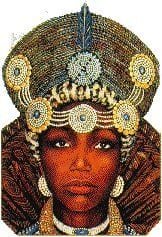Nandi KaBhebhe (1760 – 1827) was a daughter of Bhebhe, a past Elangeni chief and the mother of the great Shaka kaSenzangakhona, King of the Zulus.
Queen Nandi was a South African Zulu Queen and mother to Shaka Zulu. She was born Nandi Ndlovukazi kaBhebe in Melmoth, a small town in KwaZulu-Natal, South Africa in the 1760s. The word Nandi means ‘The Sweet One’. Her father, Bhebhe, was a minor chief. According to Zulu customs, she would have become a helper to her mother by the age of six, fetching water and eventually sowing the land and collecting firewood for the family home.
However, Nandi Bhebhe was impregnated out of wedlock by Jama’s son, Senzangakhona. The Mhlongo people demanded Senzangakhona pay damages for his non-traditional act. The Mhlongo approached the Jamas to settle the matter. Nandi was on the fore-front of this case and discussion.
Returning from a visit with relatives, Nandi and her companions encountered a group of warriors accompanying the King of the Zulu people, Senzangakhona Kajama. Nandi and the King engaged in ukuhlobonga/ ukusoma, the act of sex without penetration, an act allowed to unmarried couples. Zulu customs require courtship, a chosen groom providing a gift/ lobola to the bride’s family, and acceptance of the gift by the family before marriage and sex. The lobola is considered a payment to the bride’s family for the right to her reproductive capabilities.
Senzangakhona and Nandi went beyond ukuhlobonga/ ukusoma, and Nandi became pregnant. She informed both the King and the Elders of his village, and her claim was initially rejected. Her pregnancy, however, became more evident, and Nandi gave birth to a son she named Shaka. King Senzangakhona kaJama eventually married Nandi, making her his third wife, but locked into a forbidden inter-clan marriage. Nandi and Shaka were subject to constant abuse. Nandi finally fled the village and returned to her people, the eLangeni, leaving Shaka with his father.
As a result of this, she personally demanded 55 head of cattle as payment for damages done to her and the herd was delivered to the Mhlongo people. The Jamas and Senzangakhona agreed to pay the damages demanded by Mhlongo people so as to avoid war. On the other hand, Senzangakhona did truly love Nandi.

After Nandi gave birth to her son, Shaka, she initially spent some time at Senzangakhona’s kraal before her relationship with Senzangakhona deteriorated, forcing her to leave the kraal. A kraal is a traditional African village of huts, typically enclosed by a fence. It was also is a place of prayer in any Zulu family because that is where they communicated with their ancestors, that is where they recorded everything taking place within that family. Nandi returned to her people, the Mhlongo of Elangeni, leaving Shaka behind. Shaka’s life at Senzangakhona’s kraal proved dangerous and finally his uncle Mudli brought him to Nandi at Elangeni. During that time Nandi had to protect her son from famine, assassination attempts, and enemies. However, Nandi’s stay at Elangeni proved dangerous as well, so she left with her son to live amongst the Ncholo people. There, she met Gendeyana, whom she married and had a son, Ngwadi. Nandi’s stay amongst the Qwabe was not pleasant at all and this forced her to leave Qwabe to live amongst the Mthethwa people led by chief Dingiswayo ka Mohlatsane. Nandi was warmly welcomed by the Mthethwa. She found it a good place to raise her sons, Shaka and Ngwadi, and her daughter, Nomcoba. Her son Shaka joined a Chwe regiment led by Bhuza. It was amongst the Mthethwa where Shaka devised military tactics.
When King Senzangakhona died, Shaka took his father’s throne by force and announced that his mother, Nandi, would rule as his Queen. Nandi also became his closest advisor. She was now called Ndlorukazi, meaning The Great She Elephant. Nandi, however, ruled over the people who feared and disliked her. She rode an elephant and established regiments of all-female warriors. Shaka, however, idolized his mother and dealt harshly with her critics.
Shaka suffered more abuse without his mother, and he was returned to her. The eLangeni, however, cast out Nandi and Shaka during the famine of 1802. She fled to Qwabe, where she met and married Gendeyana and had a son named Ngwadi. Nandi once again was tormented because her second marriage, also an inter-clan bond, was also forbidden. Nandi, Shaka, Ngwadi, and her daughter, Nomcoba, were taken in by the Mthethwa (Mtetwa) people, whose chief, Dingiswayo, allowed Shaka to join the ranks of his warriors. Eventually, Dingiswayo named Shaka his successor.
Queen Nandi died of dysentery on October 10, 1827. Shaka ordered a year of mourning that included all milk to be poured out, no crops to be cultivated, and all pregnant women killed along with their husbands. He also ordered ten living maidens to be buried alongside his mother to care for her in the afterlife and stationed 12,000 soldiers to guard her gravesite.
Her grave can be found outside Eshowe, off the old Empangeni road. The grave is marked ‘Nandi’.
On 11 March 2011 the Mhlongo Committee met at Eshowe with the Office of the KZN (kwaZulu-Natal) Premier and Amafa to finalize plans for Princess Nandi’s grave near Eshowe. It was agreed that there would be an official opening day in May 2011 to present Queen Nandi Bhebhe’s grave after the approval of the designs suggested by Mhlongo people. Queen Nandi Bhebhe was born into the Mhlongo people and for that reason it was also agreed that the name on the grave shall be “Princess Nandi Mhlongo, Mother of King Shaka”. The Bhebhe and Mhlongo people of eLangeni are one people. The direct descendants of King Shaka’s mother Nandi have expressed dissatisfaction with the state of her grave which has lain unattended for over 200 years. The Zulu royal family blames the government for this because according to them, the graves of prominent people are the responsibility of government. Amafa heritage which administers protected structures in the province will soon erect a sculpture symbolic of Nandi’s status once the Mhlongo and the royal family have settled their differences.
There is no known image of Nandi. The image used is an artist’s rendering of her.
Despite the hard times they endured together, or perhaps because of them, Shaka loved his mother almost to the point of worship.
According to Donald Morris, Shaka ordered that no crops should be planted during the following year of mourning, no milk (the basis of the Zulu diet at the time) was to be used, and any woman who became pregnant was to be killed along with her husband. At least 7,000 people who were deemed to be insufficiently grief-stricken were executed, although the killing was not restricted to humans: cows were slaughtered so that their calves would know what losing a mother felt like.
What Morris states comes from Henry Francis Fynn’s memory. Fynn’s account has been disputed with some sources alleging that they were exaggerated since he may have had deeper motives. Fynn’s earlier accounts were sometimes inaccurate and exaggerated which would become crucial to the growth of Zulu mythology. Many of the first white settlers were illiterate, with the exception of a few who controlled the written record. These writers have been accused of demonizing Shaka as a figure of inhuman qualities, a symbol of violence and terror, to obscure their own colonial agenda.
Julian Cobbing also argues that these settlers’ writers were anxious to create a myth which “cover up” colonial 19th-century slave raiding and general rapine across the sub-continent and justify the seizure of land.
Additional Sources: Black Past, Donald Morris
Note: More information is being sought to complete and effectively validate and corroborate this story.




